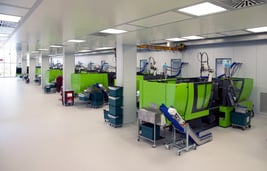The plastic injection molding industry has a long history that dates back to the 19th century in Europe and America. Throughout the decades, many chemists and inventors have used a wide variety of plastic materials in the process.
However, the types of presses and machines used in the injection molding process have boiled down to two: Hydraulic and Electric with a Hybrid machine available.
Hydraulic injection molding presses were historically the only option available until a company in Japan introduced the first electric machine in 1983. Since then, electric machines have risen in popularity. However, hydraulic machines continue to be the most widely used type available everywhere except Japan.
One of the big reasons hydraulic machines continued to dominate injection molding is because the machine itself was cheaper than electronic machines. However, the benefits of electric machines often offset that initial cost over the long haul.

Electric Machine Benefits
Traditional hydraulic injection molding machines are less efficient than electric machines because they consume energy even while in idle. Electric injecting molding machines only use energy when in action, meaning the motor output is only equal to that of the load requirements.
Electric machines are digitally controlled while hydraulic systems are driven by hoses, valves and pipes – leading to much of the lost energy. All-electric machines have the benefit of being higher speed and more efficient during the whole process because independent motors control everything from the injection to extruder to clamping and ejection.
The process can be tuned in faster with electric presses rather than a hydraulic press because hydraulic presses have a lot more components and fluids that have to come up to temperature. This allows for less start-up and run scrap, when using an electric press which saves money.
This all adds up to a faster, tighter, cleaner and more repeatable process with less waste, leading to an average energy reduction of 50 to 75 percent when compared to hydraulic machines.
Another benefit to all-electric machines is there is no chance of leakage, meaning there is less down time and material contamination. And because there is no oil or filters to replace, consumable expenses are less.
The Hybrid Option
Some have gone to a hydraulic-electric machine that offers some energy saving benefits of electric machines along with some of the added power hydraulic machines offer. However, because three of the four axes typically are hydraulic, the efficiency and energy loss makes these machines less optimal than the electric injection molding machines.
Although electric machines may be more expensive than hydraulic machines, the savings over time are dramatic, justifying the investment. This maximized performance allows companies that use all-electric injection molding machines to deliver the best products and solutions for manufacturing partners.
At Pleasant Precision Inc., we use efficient electric injection molding machines that always deliver the best quality possible. This is one of the reasons we have built a strong record of delivering high precision and success to our partners while performing under the tightest tolerances in the plastics industry.


